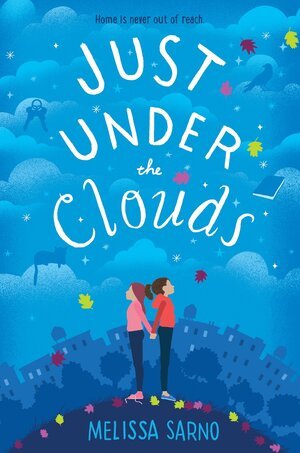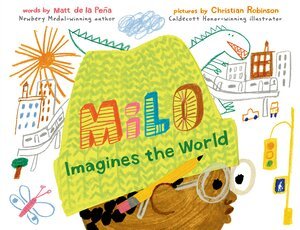Learning about Homelessness and Housing Instability: Resources for Kids and Families
Between July 1, 2019 and June 30, 2020, 31,207 people accessed help or services related to housing and homelessness in the Denver region (Metro Denver Homelessness Initiative Housing Report). We don't always know everyone's story about why they might be experiencing housing instability, but we know that everyone deserves a permanent place to live. Books and stories can reflect kids' experiences of shelter instability and they can also introduce kids to the experiences of others.
Books for Kids
About Homelessness
Crenshaw
by Katharine Applegate
Chapter book, 4th - 6th grade
“Jackson and his family have fallen on hard times. There's no more money for rent. And not much for food, either. His parents, his little sister, and their dog may have to live in their minivan. Again” (publisher’s description).
Hold Fast
by Blue Balliet
Chapter book, 4th - 6th grade
“Where is Early's father? He's not the kind of father who would disappear. But he's gone...and he's left a whole lot of trouble behind. As danger closes in, Early, her mom, and her brother have to flee their apartment. With nowhere else to go, they are forced to move into a city shelter. Once there, Early starts asking questions and looking for answers” (publisher’s description).
Isaiah Dunn is My Hero
by Kelly J. Baptist
Chapter book, 4th - 7th grade
“Isaiah is now the big man of the house. But it’s a lot harder than his dad made it look...when things get really tough, there’s Daddy’s journal, filled with stories about the amazing Isaiah Dunn, a superhero who gets his powers from beans and rice. Isaiah wishes his dad’s tales were real. He could use those powers right about now!” (publisher’s description).
Rich
by Nikki Grimes, illustrated by R. Gregory Christie
Chapter book, 1st - 3rd grade
“Free is excited about a local poetry contest because of its cash prize, but when he and Dyamonde befriend a classmate who is homeless and living in a shelter, they rethink what it means to be rich or poor” (publisher’s description).
A Place to Stay: A Shelter Story
by Erin Gunti, illustrated by Estelí Meza
Picture book, PreK - 2nd grade
“This simple, touching picture book shows readers a women's shelter through the eyes of a young girl, who with her mother's help, uses her imagination to overcome her anxiety and adjust.” (publisher’s description).
Where Will I Live?
by Rosemary A. McCarney
Picture book, PreK - 3rd grade
“Every child needs a home. They need somewhere safe where they can be happy, eat their meals with their family, play with their toys, and go to sleep at night feeling unafraid. But many children all over the world have had to leave their homes because they are no longer safe. Because of war and conflict, they and their families have become refugees” (publisher’s description).
No Fixed Address
by Susin Nielsen
Chapter book, 5th - 8th grade
“Twelve-year-old Felix's appearance on a television game show reveals that he and his mother have been homeless for a while, but also restores some of his faith in other people” (publisher’s description). Includes a discussion guide.
Still a Family
by Brenda Reeves Sturgis, illustrated by Jo-Shin Lee
Picture book, PreK - 2nd grade
“A little girl and her parents have lost their home and must live in a homeless shelter. Even worse, due to a common shelter policy, her dad must live in a men's shelter, separated from her and her mom. Despite these circumstances, the family still finds time to be together” (publisher’s description).
On Our Street: Our First Talk About Poverty
by Jillian Roberts, illustrated by Jane Heinrichs
Nonfiction, 1st - 4th grade
“A gentle introduction to the issue of poverty, On Our Street explores the realities of people living with inadequate resources. Using age-appropriate language, this book addresses mental illness, homelessness and refugee status as they are connected to this issue” (publisher’s description).
Just Under the Clouds
by Melissa Sarno
Chapter book, 4th-8th grade
“Cora is a middle schooler, a big sister, and homeless. Her mother is trying to hold the family together after her father’s death, and Cora must look after her sister, Adare, who’s just different, their mother insists. Quick to smile, Adare hates wearing shoes, rarely speaks, and appears untroubled by the question Cora can’t help but ask: How will she find a place to call home?” (publisher’s description).
About Community Connectors
Help kids understand our interconnected community through books and stories. These books build awareness of the ways that we all affect each other and point the way toward actions of community care.
Can We Help?: Kids Volunteering to Help Their Communities
by George Ancona
Nonfiction, Kindergarten - 3rd grade
“Describes how children can help their communities in different ways, from tending a community garden and training service dogs to volunteering to help people with disabilities and mentoring younger students” (publisher’s description).
Last Stop on Market Street
by Matt de la Peña, illustrated by Christian Robinson
Picture book, PreK - 2nd grade
“On Sundays, CJ and his nana ride the bus across town to their stop on Market Street. But today, CJ's not happy about it. Today, he's wondering out loud why they have to wait in the rain and why they don't have a car like his other friends. But it's Nana who opens young CJ's eyes and shows him the real beauty in the world around them - the spirit of the bustling city, the music in everyday life, and the magic of their often overlooked neighbors” (publisher’s description).
Milo Imagines a World
by Matt de la Peña, illustrated by Christian Robinson
Picture book, PreK - 2nd grade
“Milo is on a long subway ride with his older sister. To pass the time, he studies the faces around him and makes pictures of their lives. There's the whiskered man with the crossword puzzle; Milo imagines him playing solitaire in a cluttered apartment full of pets... And then there's the boy in the suit with the bright white sneakers; Milo imagines him arriving home to a castle with a drawbridge and a butler. But when the boy in the suit gets off on the same stop as Milo--walking the same path, going to the exact same place--Milo realizes that you can't really know anyone just by looking at them” (publisher’s description).
Take Back the Block
by Chrystal D. Giles
Chapter book, 4th - 6th grade
“Sixth-grader Wes Henderson sets out to save the Oaks, the neighborhood where he's lived his whole life, from being sold to a real estate developer. Exploring community, gentrification, justice, and friendship, Take Back the Block introduces an irresistible 6th grader and asks what it means to belong-to a place and a movement-and to fight for what you believe in” (publisher’s description).
When Stars are Scattered
by Victoria Jamieson and Omar Mohamed
Graphic novel, 4th - 8th grade
“Omar and his younger brother Hassan live in a refugee camp, and when an opportunity for Omar to get an education comes along, he must decide between going to school every day or caring for his nonverbal brother in this intimate and touching portrayal of family and daily life in a refugee camp” (publisher’s description).
Farmer Will Allen and the Growing Table
by Jacqueline Briggs Martin, illustrated by Eric Shabazz Larkin
Nonfiction, 2nd - 5th grade
“Will Allen is no ordinary farmer. A former basketball star, he's as tall as his truck, and he can hold a cabbage--or a basketball--in one hand. But what is most special about Farmer Will is that he can see what others can't see. When he looked at an abandoned city lot in Milwaukee he saw a huge table, big enough to feed the whole world” (publisher’s description).
Towers Falling
by Jewell Parker Rhodes
Chapter book, 4th - 6th grade
“When her fifth-grade teacher hints that a series of lessons about home and community will culminate with one big answer about two tall towers once visible outside their classroom window, Dèja can't help but feel confused. She sets off on a journey of discovery, with new friends Ben and Sabeen by her side“ (publisher’s description).
Our Little Kitchen
by Jillian Tamaki
Picture book, Kindergarten - 3rd grade
“In this lively, rousing picture book from Caldecott Honoree Jillian Tamaki, a crew of resourceful neighbors comes together to prepare a meal for their community. With a garden full of produce, a joyfully chaotic kitchen, and a friendly meal shared at the table, Our Little Kitchen is a celebration of full bellies and looking out for one another. Bonus materials include a recipe and an author's note about the volunteering experience that inspired the book” (publisher’s description).
Harbor Me
by Jacqueline Woodson
Chapter book, 4th - 6th grade
“When six students are chosen to participate in a weekly talk with no adults allowed, they discover that when they're together, it's safe to share the hopes and fears they have to hide from the rest of the world” (publisher’s description).
Additional Resources for Adults
How Redlines Built White Wealth: A Lesson on Housing Segregation in the 20th Century from the Zinn Education Project
Learning Plan: Homeless and Learning Plan: Facing Homelessness from Learning for Justice, a project of the Southern Poverty Law Center
Pushed Out: Displacement Today and Its Lasting Impacts from Urban Displacement Project
Sesame Street in Communities: Family Homelessness
State of Homelessness Report 2020 from Metro Denver Homelessness Initiative
“What do I say?” How to talk to kids about homelessness by Connie French, United Way of Massachusetts Bay and Merrimack Valley



















